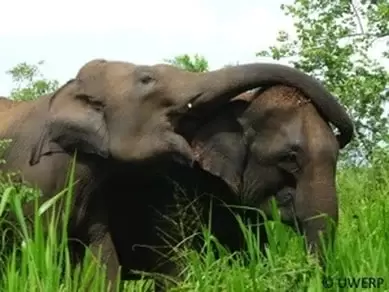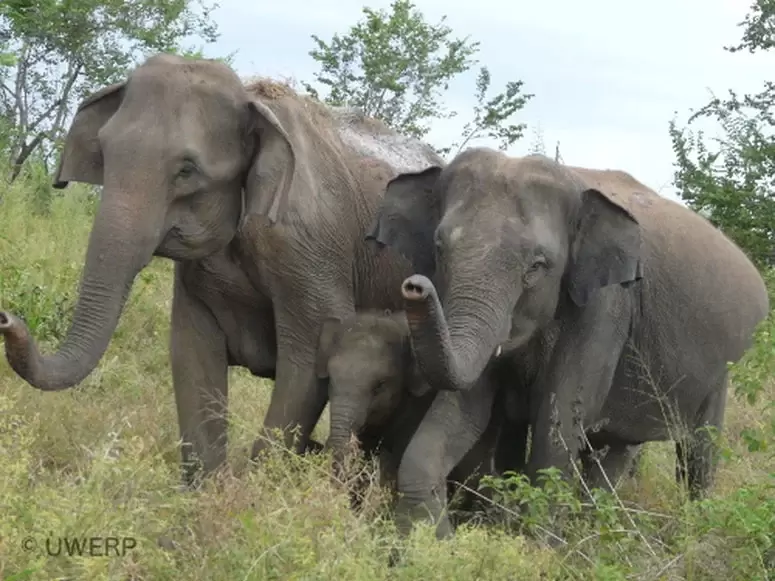BasicsThe Asian Elephant (Elephas maximus) is the only living species of the genus Elephas and is distributed throughout Asia from India in the west to Borneo in the east. All Asian elephants are currently classified as a single species, although there are several subspecies. The largest populations exist on the mainland, sometimes referred to as E. m. indicus. The population on the island of Sri Lanka is referred to as E. m. maximus, and represents the original "type" specimen for the species. Genetically it is very similar to the mainland population. The Bornean and Sumatran populations are designated as subspecies E. m. borneensis and E. m. sumatranus respectively. The elephants of Sumatra may be especially unique, having diverged earlier from all other populations and possessing an extra pair of ribs.
Elephants are known as "generalist" herbivores because they can eat practically any vegetation, and so they are found in diverse habitats ranging from dry, open grasslands to wet, dense rainforests. Females are referred to as 'cows' while males are referred to as 'bulls' and immature animals are known as 'calves'. Asian elephants can live as many as 80 years in captivity, and in some wild populations may live 60 years or more. Females have a gestation time of 20-22 months, which means they reproduce slowly. Optimally, females can have a calf every 3-4 years, but more typically it may take 6 years or more [read more]. Elephants are an integral part of cultures throughout Asia, serving both in religious symbolism as well as day-to-day labor for more than 5000 years! That's a time span comparable to when horses were first domesticated. But unlike horses, Asian elephants have never truly been "domesticated," in the sense that they have not been bred in captivity over multiple generations by humans to serve our needs. |
|
Behavior Spectrogram of an Asian elephant "growl". Spectrogram of an Asian elephant "growl".
Elephants communicate using sound and scent. African elephants are also very sensitive to seismic cues, though similar research on Asian elephants is lacking. They produce a number of distinct vocalization types, ranging from very low frequency 'growls' and 'rumbles,' which may contain infrasonic components (below our hearing range), as well as high-pitched squeaks, squeals and trumpets. A male captive elephant named Koshik has even been demonstrated to imitate several words of Korean, an extremely rare ability among mammals. Asian elephants show various aspects of higher cognition, such as self-recognition, insightful problem solving, cooperation, and perhaps even reassurance and empathy. We are just beginning to scratch the surface of the complex social lives of this shy and mysterious species.
 An adult female shows her dominance by putting her trunk over the head of another. An adult female shows her dominance by putting her trunk over the head of another.
Asian elephants are large-brained, and quite social. As with many mammals, females and young form herds while males separate from these herds during their teenage years to form their own parallel societies. Like their cousins, the African savannah elephant (Loxodonta africana), it's likely that the female herds typically consist of related individuals and herds may occasionally join up and mingle with one another. But unlike the African elephant, where the eldest female or 'matriarch' manages a very close-knit family that usually travels everywhere together, female Asian elephants tend to be very flexible and dynamic in their relationships over time [read more]. More research is needed in the different populations and subspecies to determine whether social organization shows variation in different environments.
Mature bulls enter a period known as 'musth' which is similar to rutt in deer, which follows an annual cycle the timing of which is unique to each male. During this period they exhibit streaks of liquid from their temples, dribble urine and give off a strong odor detectable over very long distances. Competition for females is fierce and although males can also try to reproduce when not in musth, the heightened aggression of musth males gives them an edge in winning. Surprisingly, in those populations containing a mixture of males with and without tusks, there seems to be no clear advantage to having these formidable weapons when it comes to winning contests, with body size and musth largely determining outcomes. |





